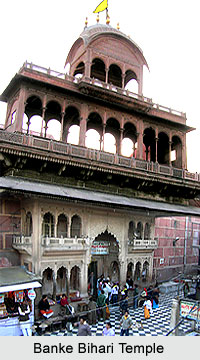 Originally Banke Bihari was worshiped at Nidhivana. Banke means "bent in three places" and bihari means "supreme enjoyer." Lord Krishna is in the Tribhanga posture. This deity was originally worshipped under the name of Kunji-bihari.
Originally Banke Bihari was worshiped at Nidhivana. Banke means "bent in three places" and bihari means "supreme enjoyer." Lord Krishna is in the Tribhanga posture. This deity was originally worshipped under the name of Kunji-bihari.
History of Banke Bihari Temple
Banke Bihari Temple was established by Swami Haridas of the Nimbarka Sampradaya. It is believed that he discovered the Banke Bihari deity at Nidhivana, sometime in the 16th century. When this temple was constructed in 1864 Banke Bihari was moved here. Banke Bihariji was worshiped alone. Later the deity of Radharani was added.
Rituals of Banke Bihari temple
During Jhulan Yatra or the swing festival of Lord Krishna one can see several silver-plated and some solid silver ornamented swings. The main day of Jhulan Yatra is the third day of the waxing moon, at which time Banke Bihari is placed on a golden swing (hindola). Every few minutes the curtain is pulled shut and then opened again. This is the only temple where loud temple bells are not used to wake Krishna in the morning.
Mangala-arati is only one day a year in this temple, on Janmasthami. Only one day a year the lotus feet of the Deity can be seen, on Akshaya, on the third day of the bright half of the month of Vaishaka. The autumn full moon day is the only day that the Deity holds a flute, wears a special crown. Banke Bihari can be seen in full view on the last five days of the month of Phalguna, during the Holi festival.
This article is a stub. You can enrich by adding more information to it. Send your Write Up to content@indianetzone.com





















